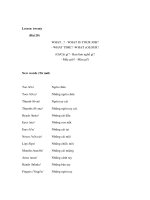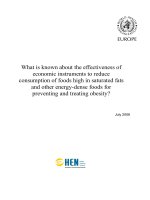Garment Processing - What is Garment Processing
Bạn đang xem bản rút gọn của tài liệu. Xem và tải ngay bản đầy đủ của tài liệu tại đây (826.78 KB, 35 trang )
Garment processing
INTRODUCTION
o
The concept of garment dyeing is not new. Even in good old days, the old garments
used to be dyed by households or by commercial launderers, which was basically
done for changing the color of the faded garments to have a newer look. Articles
like towels, linens, napkins, table cloth, hosiery goods, etc, are being processed in
the ready made form only since the last four decades.
o
The garment dyeing of cotton garments such as trousers, jackets, shirts, skirts and
tops is gaining popularity and is relatively new trend in the Indian garment industry.
Garment dyeing has now become an important segment of apparel industry and its
potential has yet to be exploited in India. Our society is gradually becoming more
sensitive towards quick fashion changes, probably due to influence from the
western countries. Therefore , it becomes necessary for garment suppliers and
manufacturers to fulfill the customer’s demand by changing over to quick response
system.
What is Garment dyeing ?
o
Garment dyeing may be defined as the application of color to fully
fashioned apparel articles and these fashioned apparel articles may be in
the form :-
o
Garments cut and sewn from either prepared or unprepared knitted fabrics
and then dyed.
o
Garments and / or components knitted from either prepared or unprepared
yarn then dyed.
o
Garments manufactured from either prepared or unprepared woven fabric
and then dyed.
o
Mixed fabric garments, i.e., woven and knitted fabrics manufactured from
prepared fabrics and then dyed.
Out of four types of textile processing
viz fibre processing, yarn processing,
fabric processing and garment
processing, the last option garment
processing has gained momentum in
past few years due to denim garments
which is the largest garment segment
being processed by this method.
There are many advantages of wet
processing of denims like it give
various novel effects and various
processes like bleaching could also be
done at preferred parts of the garments
and so on. There are mainly two sub-
segments of garment processing:-
Garment wet processing
The dyeing of the garments
demands more care than fabrics due to
the fact that the processing involves
value added goods.
The entire garment dyeing activities
may be broken down into four
categories, namely, fully fashioned
garment dyeing, cut and sewn garment,
dyeing of 100% cotton goods for
boutique trades and processing of
denims leading to stone wash, acid
wash, washing and highlighting effects.
Garment processing comprises of
Wet processing machines
classificationPaddling machineDrum machineWashing-centrifuging Jet dyeing centrifuging
Garment dyeing machines and their
principles
Types of construction Types of liquor and
government movement
1. Paddling machine Mechanical arrangements
like paddle, drum
2. Drum machine Hydrodynamic movement
with adjustable jets
3. Washing-centrifuging machines Hydrodynamic circulating dyeing
machines with so called floating
liquor circulation principle
4. Jet dyeing centrifuging machines Jets and nozzles are used to
facilitate movement of the
garments
Paddling machine
o
It consist of either horizontal or vertical
paddles .
o
Paddles are widely accepted for sweaters,
loosely knitted goods due to their soft
dyeing action, which avoids abrading and
pilling of the garments.
o
For gentleness, the dyeing is carried out
with m:l ratio of 30:1 to 40:1, the blades
of the paddle are either curved or rounded
and the rotating speed of the paddle can be
regulated from 1.5 rpm to 40 rpm.
Overhead paddle, lateral paddle and high
temperature paddle machines serve the
needs of the entire range of the garments.
Washing centrifuging machine
o
This machine with multi-pocket
designs have compartments to
control garment movements,
abrasion due to mechanical action
by carrying the garments through
the dye liquor in the
compartments.
o
By making more compartments’
the tumbling effects and the
entanglements in the garments are
reduced and also are the abrasions
associated with it.
Drum dyeing centrifuging type
o
In drum type machines, a perforated drum is
suspended lengthwise in a horizontal
position, submerged in the dye liquor .
o
The drums are divided into compartments
and are capable rotating in both the
directions at 2 rpm to 20 rpm, where
temperature varies up to 140°c.
o
Drum dyeing centrifuging machines are also
called multipurpose drum machines or multi-
rapid dyeing-centrifuging machines, since
these machines can perform scouring,
dyeing, centrifuging and conditioning
successively with automated controls.
Jet circulation machine
In jet machines, the dye liquor and
goods are kept in circular motion
by jet nozzles whose direction and
force are adjustable.
Turbulence nozzles at the bottom
ensure liquor circulation, prevent
goods from sinking and allow
opening them.
the machine capacity varies from
25 kg - 125 kg of dry weight with
m:l ratio of 1:25 to 1:40 and
temperatures as high as up to 130°
C.
Garment Finishing :-through wet processing is
responsible for adding beauty to the garment, proper
finishing could provide better look to the garment, change
the feel of the fabric and bring about a change to the
fabric. Typical denim wet finish includes desizing to
soften the fabric and stonewashing to remove color and
add contrast to the fabric.
DESIZING:- Desizing is the process in which the size applied to the
warp yarn before weaving is removed to facilitate the penetration of dyes and
chemicals in the subsequent wet processing operation. The purpose of sizing
is to form coating of sufficiently strong and woven fabric.
Types of Desizing:-
1. Acid desizing – In this method cotton fabric is treated with dilute sulphuric
acid with a concentration of 5-10 gpl at temp of 40oc for 3-4 h. Dilute acid
attacks the polymer chain of starch and due to chain cleavage of starch
molecule short water soluble or dispersible chain segments are formed.
2. Enzymatic desizing – Enzymes have become extremely popular in the
industry because they are easy to use and applicable in many process.
o
Enzymatic desizing carried out for denim garment by passing
it through hot water and then padded with the desizing mixture
containing 0.5-2% malt extract and Non-ionic wetting agent at 60-70˚c.
o
Wetting agents helps the enzyme to penetrate the size film.
Process Conc(g/l) Ph temp0c
Malt Diastase 3-20 4.5-5.5 50-60
Pancreattic Diastase 1-3 6.8-7.5 50-60
Bacterial Diastase 0.5-1 6.5-7.5 60-70
Desizing with amylases – enzymatic desizing using α amylase is
the most popular method to remove starch and has been used in the
textile industry for several decades. Alpha amylase break down the
starch into water soluble sugars by cleaving internal 1,4 linkages.
Although natural sizes of starch origin can easily be removed by alpha
amylase, variable such as enzyme type and concentration, process, ph,
temperature, time, mechanical action should be properly controlled to
achieve the best desizing results.
Advantages of enzymatic desizing over acid desizing:-
o
Higher efficiency and specificity in action
o
No fibre damage
o
Avoiding the use of hazardous chemicals
o
Ability to use wide range of process conditions including processing at
room temperature and complete biodegradbility of the effluent.
Stone washing :-
Stonewashing added new dimension to
denim garments in the late 1970s; the
process enabled artificial ageing of denim
garments, which imparted a fashionably
aged new look. As the name ‘stonewashing
‘ implies, the blue jeans were washed with
pumic stones to achieve a faded look.
•
Process:-The jeans are washed with oval
or round pumice stones which should all
have roughly the same format. The pumice
stones are very light with a rough surface.
Normally after desizing, Stone wash
process starts with pumice stone addition
in rotary drum type garment washer,
process time varies from 60-120mins.
Degree of colour fading depends on:-
o
Stone ratio –{ stone weight to f/c weight (0.5 – 3:1)}
o
Washing time
o
Weight of stones
o
Load of garments (heavy denim, heavy stone)
Sequence of stone washing :-
1. Load the machine with garment
2. Desizing – oxidative or enzymatic
3. Rinsing
4. Load machine with stones
5. Run machine for 30- 60 min depending on the abrasive effect
6. Rinsing
7. Tumble dryer
Disadvantages of stone wash
1. Machine damage
2. Fabric may damage
3. Stone dust
4. Effluent treatment
.
ENZYME WASH
Limitations and drawbacks associated with stone washing process, can be
overcome by using new enzyme based washing technology.
o.
Cellulase enzymes are natural proteins which are used in denim garment
processing to get stone wash look on to the denim garments without using
stones or by reducing the use of pumice stone.
o.
Cellulase attacks primarily on the surface of the cellulose fibre, leaving the
interior of the fibre as it is,by removing the Indigo present in the surface of the
fibre.
Denim bleaching: In this process, as a stone oxidative bleaching agent such as
sodium hyprochlorite or KMNO4 is added during the washing with or without stone
addition. This coloration is usually more apparent depending on the strength of the
bleach liquor, quantity, temperature and treatment time.
o
Sequence :-
1. Load the machine.
2. Desize (oxidative)
3. Rinse
4. Bleaching (hypochlorite)
5. Rinse
6. Antichlor treatment to remove residual chlorine
7. Rinse
8. OBA / FBA optional
9. Rinsing
10. Tumble dryer
LIMITATION:-
1. Process is difficult to control i.e. difficult to reach the same level of bleaching
in repeated runs. When desire level to bleaching reach the time span available
to stop the bleaching is very narrow.
2. Due to the harshness of chemical, it may case damage to the cellulose resulting
in sever strength losses and / or breaks or pinhole at the seam, pocket, etc.
3. Required antichlor treatment.
4. Problem of yellowing is very frequent due to residual chlorine.
o.
Biobleaching with laccase and mediator :-
laccase is the newest enzyme class to be introduced into denim
finishing.laccases are multi-copper oxidases that catalyze the oxidation of a
wide range of phenols, including indigo, under simultaneous reduction of
oxygen to water. Laccases alone are not effective in decolorizing indigo on
denim and require a mediator, which mediates electron transfer from indigo to
moleculer oxygen. Since the laccase and mediator only degrade indigo
Cont………
without affecting the weft yarns, the resulting finish exhibits unique washdown
of denim, with grey cast
Garment pigment dyeing
PIGMENTS: These are the organic
coloring compounds having no
affinity for the fibres.
Pigments have no chemical reaction
with the substrate and require
adhesive,resin or bonding agent for
fixation on fabric.
The main reason behind their usage
is distressed washed out and faded look
Pigment dyeing :-
o
It is refers to the application of pigments just
like dyes by an exhaust method or pad
application.
o
Generally pigments are either anionic or
non-ionic in nature when disperse in water
when applied on cellulose will not have
affinity towards anionic cellulose in the
dyebath.
o
So Ionic nature of the fibres are changed
prior to the dyeing by different types of
cationic pretreatments.
Types of pigments
o
Cationic polymers :are used that form a layer of cationic
charges when applied to the fibre surfaces, eg: Polyacrylates,
Polyimidazoles, Poluamino condensates.
o
Reactants: are the small molecules that modify the fibres by
forming covalent bonds with the cellulosic fibres.These cationic
pretreatments creates cationic charges on the fibre which causes
anoinic materials(Pigments) to be strongly attracted to the fibre.









